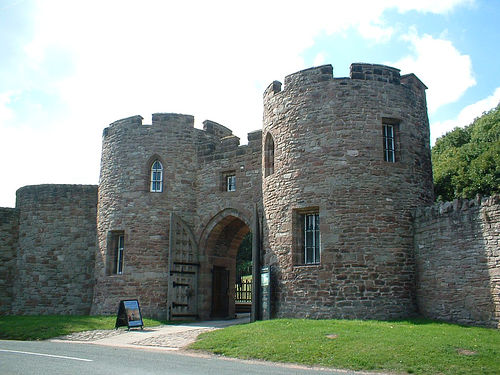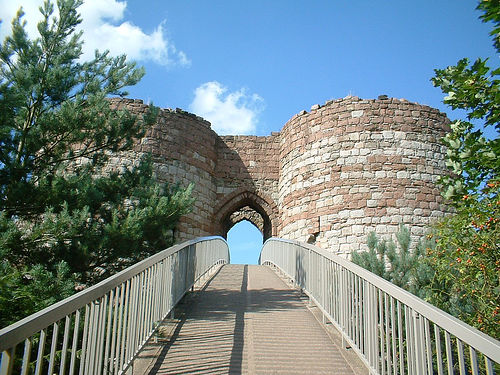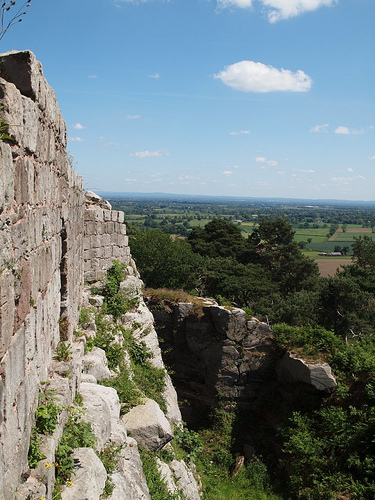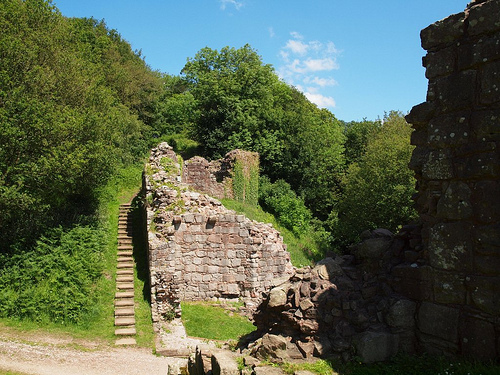

Location: Beeston, Cheshire County Map
Constructed: 1220's by Ranulf de Blondeville


Beeston Castle is a medieval citadel that served as a royal residence when it was constructed. Beeston Castle is situated in a town of Beeston in Cheshire County in United Kingdom. It was constructed in 1220's by Ranulf de Blondeville. It is located in an elevated position, on a sandstone boulder about 110 meters high on the Cheshire plain. In 1237, Henry III of England took possession of Beeston and the castle was kept in good condition until the sixteenth century, when the decision was made not to use it for military purposes, although it was used again in 1643. Like many castles in the area it was badly damaged in 1646 during English Civil War. The Royalists defended the castle from November 1644 until November 1645. Eventually they were forced to give up their citadel due to famine that started in the fort. In 1646 Beeston Castle was badly damaged and finally abandoned as a military fortification. The castle was partially demolished in 1646 to prevent it being used again as a fortress. In the eighteenth century the place was used as a quarry.

It is rumored that in the gardens of the Beeston castle remains buried a treasure belonging to Richard II of England, but none of the many searches that have been carried out have given any sign of it. Beeston castle, now in ruins, is classified as Grade I on the list of buildings in the United Kingdom, qualified as a protected old building (planned monument), and is owned by English Heritage.
The Beeston cliff is part of a chain of rocky hills that runs
along the Cheshire plain. Archaeologists have discovered flint
arrowheads on the cliff dating back to the Neolithic , as well
as remains of a Bronze Age settlement , dated about 800 BC, and
a castro of the Iron Age dated around the year 400 AD The
location of the walls on the outside of the feudal speck was
chosen to take advantage of the remains of the Iron Age walls.
Beeston Castle was built by Ranulph de Blondeville, sixth Earl
of Chester, as an impregnable fortress and symbol of power. The
castle is described in medieval documents such as Castellum de
Rupe , the castle in the rock. Next to Bolingbroke Castle , in
Lincolnshire , it was one of the two important castles built by
Ranulph in the 1220s, shortly after his return from the fifth
crusade . 6Unlike many other castles of the time, Beeston Castle
does not have a speck as the last defensive line. Instead, the
natural elements of the land next to the huge walls, strong
doors and carefully placed towers, make the outer walls a
fortress in themselves. The defenses have two parts. The first
one is a small walled interior, or fortified wall, located at
the top of the hill, with a steep slope on three sides and a
moatdefensive nine meters deep carved into the rock of the
quarter of the sides. The second part of the defenses, an
exterior walled enclosure, was built in the lower part of the
hillside, and has a huge guard's house protected by another pit,
this one five meters wide and three deep.
The outer enclosure was more or less rectangular, with the walls
covered with sandstone and filled with rubble, three meters
thick. The walls, of which there are still some remains, had
some D-shaped towers, an innovation in the English castles of
the time. The towers allowed the defenders to shoot through
forward, but by design, with the back open, they did not offer
coverage in the event that the attackers managed to get inside
the enclosure. The inner enclosure was located on the rocky top,
at the west end of the cliff.
Two wells were excavated in the rock to supply fresh water to
the inhabitants of the castle, one of which, 113 meters deep, is
one of the deepest wells located in castles in England. It is
believed that Ranulph de Blodeville himself was responsible for
the design of the castle, drawing on the fortifications he had
seen during the time he spent in the Holy Land during the
Crusades, although he could not contemplate the finished castle.
Although most of the defenses already existed in 1232 , the year
of Ranulph's death, at that time there were no dependencies or
barracks, and there were none at the death of John, Ranulph's
successor, in 1237 . Count John died without a male heir and
King Henry III of England took possession of the county of
Cheshire and therefore of Beeston Castle. Henry III extended the
castle during his wars against Wales , being used as a prison
for Welsh prisoners. However, no attempt was made to equip the
castle as a permanent residence with halls and chambers.
Probably the garrison was housed in wooden structures located
inside the interior enclosure
In 1254 , Henry III gave Beeston, along with other lands in
Cheshire, to his son, Prince Edward , as well as the title of
Earl of Chester , title that has since held the heir to the
throne of England . In 1272 , Edward was crowned king of England
and completed the conquest of Wales. During Edwardreign and
during the fourteenth century , Beeston Castle was improved and
maintained in good condition. However, in the sixteenth century
it was considered that the castle was no longer to be used by
the British Crown and in 1602 it was sold to Sir Hugh Beeston of
Beeston Hall.
There have been persistent rumors that there is a treasure
hidden by Richard II of England somewhere in the gardens. It is
assumed that Richard II hid part of his wealth in Beeston on his
trip to Chester in 1399 , before taking a ship to Ireland to
quell the rebellion that had exploded on the island. On his
return, Richard was deposed by Henry, Duke of Lancaster , who
would reign under the name of Henry IV , and it is said that his
treasure has remained hidden. Numerous searches have been
carried out, most of them in the deep well of the inner walled
enclosure, but nothing has ever been found.
During the English civil war many castles were
used again for military purposes that were no longer taken into
account. On 20 February as as 1643 , forces parlamentaristas
commanded by Sir William Brereton. They took Beeston Castle and
repaired the walls and emptied the well. During that year, part of
the royal army of Ireland arrived in Chester. On the night of
December 13, Captain Thomas Sandford and eight soldiers of that army
sneaked into the castle (possibly helped by some traitor) and
surprised the castle governor, Captain Thomas Steele, who was so
taken aback by the event that He surrendered on condition that they
let him leave the castle with honors. Steele was tested and beaten
for his failure to defend the castle.
The monarchists managed to resist for a year the siege of
parliamentary forces, from November 1644 to November 1645 , when the
lack of food forced them to surrender. In 1646 , a war council was
held in Warrington , where it was decided that the defenses of the
castles of Halton and Beeston should be dismantled to prevent it
from being used again as a fortress, so the castle was partially
demolished.
During the 18th century, the castle's gardens served as a quarry and
the main door of the inner enclosure was demolished to build a track
so that the stones could be removed from the place. In 1840 , the
castle was bought by John Tollemache , first baron of Tollemache, at
that time the main landowner of Cheshire, as part of a major
purchase. 11 In the mid-19th century, the castle was the place where
a two-day charity party was held to raise money for local orphans
and widows. It seems that the event became quite popular, attracting
more than 3000 visitors a day.